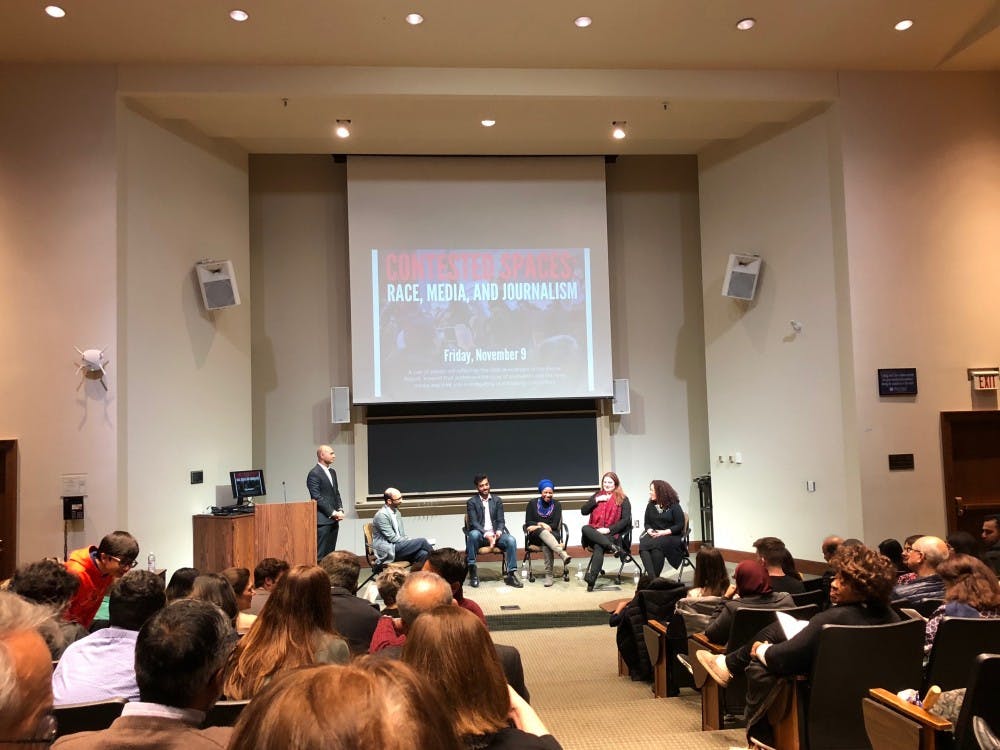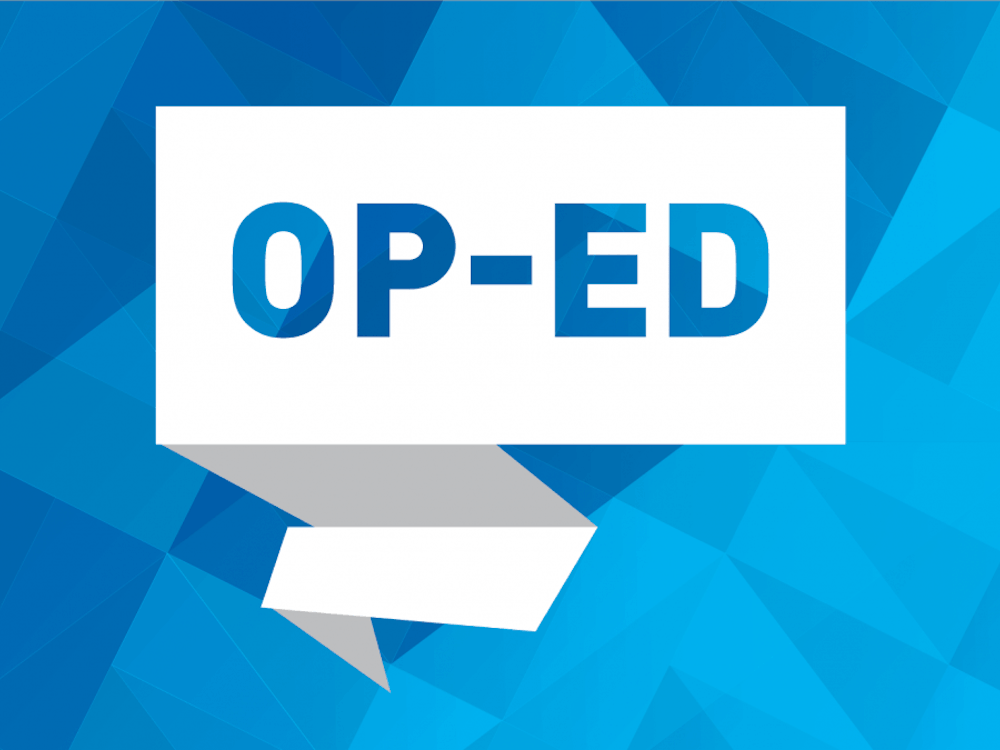Editor's note: Shahan Mufti is The Collegian's faculty adviser.
The journalism department hosted “Race, Media, and Journalism,” a program to commemorate the 50-year mark since the release of the Kerner Commission report, which addressed race in journalism and media, on Friday.
The day's events were a part of the School of Arts and Sciences theme for programming this year of "Contested Spaces: Race, Nation, and Conflict."
The first panel of the journalism program focused on prominent black journalists. Moderated by journalism professor and department chair Robert Hodierne, panelists Maureen Bunyan, Paul Delaney and Askia Muhammad shared their respective stories of being black in the news and media industry during the second half of the 20th century through today.
“The media report and write in the standpoint of a white man’s world," Hodierne said. "If you had walked into a newsroom in the 1960s at any major metropolitan newspaper or TV station or network, it would look a lot like me, old white men.”
Delaney, a former editor and correspondent for the New York Times, agreed with Hodierne’s statement regarding the demographics within the news world.
“The Washington bureau had not had a black reporter before me," Delaney said. "I was the first. That was 1969.”
Muhammad, former editor-in-chief of Muhammad Speaks, was given an opportunity to work for Newsweek because of the heated climate surrounding the civil rights movement and desegregation, he said.
“Newsweek hired 12 interns in 1968, all of whom were African American because this was the summer after Martin Luther King had been assassinated,” Muhammad said.
Bunyan, former editor-in-chief of WTOP, took part in a program by Columbia University to promote diversity in the news.
This program afforded African Americans, other people of color and women an outlet to the media industry.
Despite these programs, however, minority groups often lacked a voice in the workplace and still were heavily discriminated upon, the panelists said. For example, Delaney said he had been unable to voice his opinion during the senior-editor weekly meetings merely because of his race.
Enjoy what you're reading?
Signup for our newsletter
Similarly, when Bunyan was looking for a new job position, she was blatantly discriminated against because of her appearance, she said.
“The director told me, ‘We are not hiring because you don’t look black enough. Your hair is long, so if you want to work with us you need to cut it and put it in an Afro … and you don’t sound black,’” Bunyan said.
Wajahat Ali, Hannah Allam, Malika Bilal and Carmel Delshad spoke at a second panel Friday night. Shahan Mufti, also a professor of journalism, moderated the panel, asking questions about the panelists' experiences of being journalists who cover Muslim Americans.
These journalists identified themselves as storytellers. This was, in part, shaped by their experiences as Muslims during 9/11, they said.
Delshad, an editor and reporter at WAMU in Washington D.C., said she had gone from the girl who brought prayer rugs to show-and-tell to the girl who was a terrorist. Part of what sent her on a trajectory to being a journalist was misconceptions about Muslims, she said.
“One day when I was in class, a girl said, ‘Lets just drop bombs on all [Muslims] and be done with it,’” Delshad said.
Ali, a New York Times contributing op-ed writer, recalled the difficulty in being an Islamic citizen since 9/11.
“All of a sudden, the microscope was on us, hyper-screwed,” Ali said. “The only way we have been able to fight back is through art and culture and storytelling.”
Allam, a national reporter for BuzzFeed News, talked about the importance of redefining perceptions of Muslim Americans through journalism.
“I always say there are 3.4 million Muslims in the United States, and that there are 3.4 million ways to be a Muslim in the United States,” Allam said.
Allam also spoke about the importance of remaining objective when writing about controversial issues, both in general and within Muslim communities.
Allam had to stick to this principle, even when she covered the death of a Muslim teenager, Nabra Hassanen, who was killed during Ramadan two years ago in Northern Virginia.
Delshad had also extensively covered Hassanen’s death. She said that when covering this piece, she had had to strike a balance between being impartial and doing what to her was morally right and respectful.
Delshad said that her Islamic background not only had allowed her to continually remain objective, but also had been an asset. She said it had allowed her to find connections in the piece and add color to her work through context that she otherwise might not have known.
Bilal, a producer for Al-Jazeera English, talked about her experience in covering the joys of Muslim Americans. Bilal wrote an article about Ibtihaj Muhammad – a U.S. Olympic fencer – being the first Muslim woman to be a Barbie doll. Her Barbie doll also wore a hijab -- a headscarf.
“It is also really amazing to have a toy, or a collector's item, if you will, that looks like me," Bilal said. "And looks like my nieces.”
Another joy that Bilal was able to cover was the midterm election this past Tuesday, in which two Muslim women, Rashida Tlaib and Ilhan Omar, were elected.
“It’s incredible," Bilal said regarding the results of this past election. "I can’t believe it has taken this long, but I also can’t believe it happened.”
Ali resonated with the idea of sharing the triumphs in Muslim-American communities as well as the hardships. He said because of the existence of Islamophobia, and all of the violence connoted with Islamic communities, jubilance was an equally valid story and an emotion that people shouldn’t forget.
Panels, such as UR’s and others around the country, are important, especially because they reach out to young people who are interested in journalism, Allam said.
The panelists stressed the importance in recognizing that humans are multiple identities and shouldn’t let a singular one, such as their culture, dictate who they are. UR students and aspiring journalists can help provide quality coverage of Muslim-American communities, beyond their culture, through equally representing their other identities, the panelists said.
“There is a role of all of us with some privilege to speak up,” Ali said. “It is getting better, but we still have a lot of work to do.”
Contact news writers Emily Mendelson and Olivia Diaz at emily.mendelson@richmond.edu and olivia.diaz@richmond.edu.
Support independent student media
You can make a tax-deductible donation by clicking the button below, which takes you to our secure PayPal account. The page is set up to receive contributions in whatever amount you designate. We look forward to using the money we raise to further our mission of providing honest and accurate information to students, faculty, staff, alumni and others in the general public.
Donate Now



